Gordon Parks’ The Learning Tree (1969): Criterion Blu-ray review
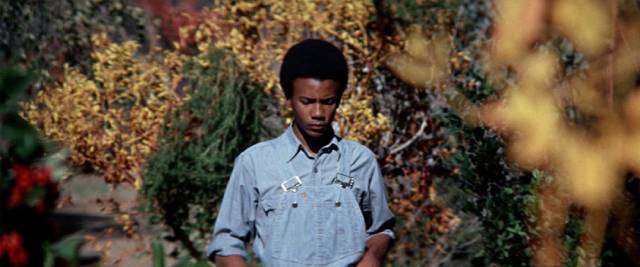
Some films of obvious historical importance nonetheless end up not being widely known. In 1968, acclaimed stills photographer, writer and musician Gordon Parks was given the opportunity to become the first Black director to make a film for a major studio (Warner Brothers). He was to adapt his own semi-autobiographical novel The Learning Tree, published five years earlier. Parks had been introduced by John Cassavetes to Warner executive Kenny Hyman, who gave him remarkable autonomy – not only would Parks write the script and direct, he would also produce and write the score. Thus he was given an opportunity previously enjoyed by very few filmmakers – like Charlie Chaplin and Orson Welles. This was an enormous amount of responsibility for a first-time feature director (at the time, Parks had only been involved in three short documentaries as writer and/or director).
With award-winning cinematographer Burnett Guffey and a cast of mostly unknowns, Parks went back to the small Kansas town where he had been born and shot the film in the place where he had personally had many of the experiences depicted in the story. There’s an obvious love for this place which gives The Learning Tree a nostalgic glow, but cutting through this is the constant presence of potential violence. In Fort Scott, Blacks and whites live in a kind of uneasy balance. The Black community is vibrant, the bonds of family strong, but the racism is casually omnipresent. Verbal slights inflict endless small emotional scars and sometimes trigger physical violence.
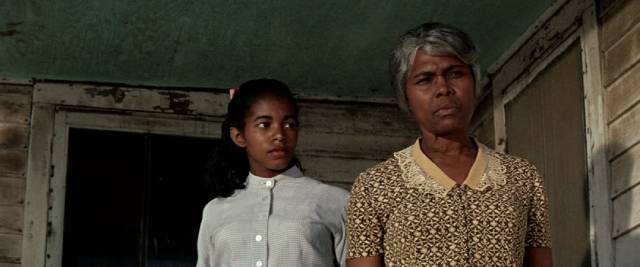
In Parks’ narrative, this conflicted atmosphere plays out in the lives of two boys who end up with very different fates. Newt (Kyle Johnson) exists within a supportive and protective family, whose matriarch Sarah (Estelle Evans) possesses a fierce strength which may be rooted in her religious beliefs but also has a practical edge, a deep understanding of the pitfalls which lie in wait for her teenage son. This portrait of his mother edges towards hagiography, but is firmly grounded by Evans’ performance, maintaining a sense of psychological realism.
Marcus (Alex Clarke), on the other hand, is deeply scarred, a motherless boy living with his abusive, alcoholic father (Richard Ward). Marcus is prepared at every moment to lash out, not just at the whites who look down on him, but also at Newt whose comparatively comfortable life he resents. While Newt tries to navigate the world shaped by the prejudiced society he lives in, Marcus pushes back and as a result brings down the weight of that society’s hatred – he’s sent to prison and severely abused, while Newt manages to find some tentative support for his ambitions.
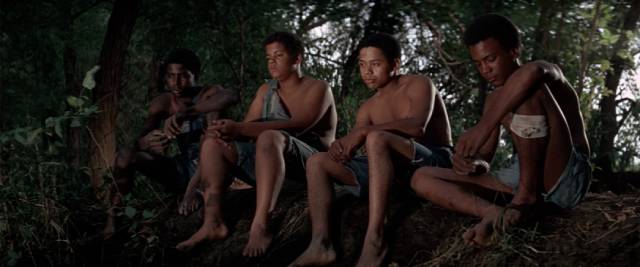
Parks resists pat extremes, adding some nuance to the inequalities experienced by Newt. In a key sequence, the boy confronts his teacher Miss McClintock (Peggy Rea), disputing a mark she’s given him. Her response is to tell him that he should forget his ambition to go to college – education, she says, is a waste of time and resources for Black kids because they’ll only end up in menial jobs anyway. He has the audacity to react by telling her that since she obviously hates Black kids, they in turn hate her. Appalled, she drags him to the principal’s office, where he unexpectedly encounters sympathy and understanding. The principal is one of two white authority figures – the other is Judge Cavanaugh (Russell Thorson) who delivers one of the film’s most overtly stated messages at the dramatic climax – who pointedly prefigure a shift in racial relations which would be partially achieved by the Civil Rights movement which was at its height when Parks wrote his novel.
At its core, The Learning Tree is a familiar coming of age story. It’s about a teenager navigating the transition from childhood to adulthood, experiencing first love, a sexual awakening, trauma and death, on the way to escaping the close confines of the place into which he has been born. But all of this takes place within the fraught context of racial conflict and violence. Early in the film, Newt, Marcus and their friends go to steal apples; they are caught by the farmer (George Mitchell), who begins to beat Marcus with a whip, and as the others run Marcus fights back, putting the farmer in hospital. While Marcus ends up being sent to a brutal reformatory, Newt atones by offering to repay the theft with free labour.
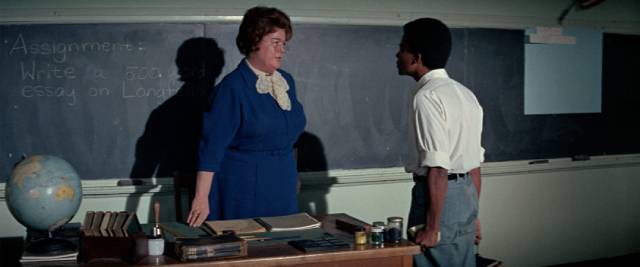
More shockingly, as the boys skinny dip in the local river, officer Kirky (Dana Elcar) chases a Black man down the bank and shoots him in the back as he tries to swim away. The killing occurs almost casually – the racist Kirky takes it for granted that he has the power and authority to execute a Black man. He then pays the boys a few quarters to dive in and pull the body from the murky water. This incident is echoed at the film’s end in the fate of Marcus. The same casual violence, the same assumption of white authority over Black lives (and deaths), but Newt himself has changed, having gained knowledge of himself and the world in which he lives.
That hard-won knowledge arrives through the moral quandary Newt faces when he witnesses a murder and has to figure out his own responsibilities. To give his evidence that he saw a Black man kill a white man is likely to trigger a wave of violence against his own community; to remain silent will probably lead to the execution of an innocent (white) man. The choice he makes leads to the judge’s lecture to racists in his courtroom, but also to the fatal conclusion of Newt’s ongoing conflict with Marcus. The racism which permeates this society imposes intolerable burdens on those who are trapped within it.
*
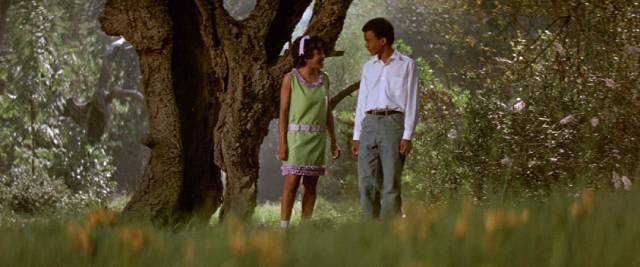
Working with Guffey, Parks fills this world with striking imagery, displaying his own photographer’s instinct for telling detail. The film begins with a spectacular evocation of a devastating storm, Newt out on a hilltop as a tornado gathers and approaches; injured, he’s found by a woman (Carole Lamond), who gets him to shelter, and using her own body to warm him provides an hallucinatory introduction to sex. This audacious prologue to the story inevitably evokes another Hollywood coming-of-age story – The Wizard of Oz (1939) also begins with a tornado sweeping across Kansas and carrying its young protagonist on a hallucinatory journey to self-knowledge, but where that movie situates its fears and nightmares in a fantasy realm, The Learning Tree remains in the real world, a place without magic, which cannot be escaped.
Parks occasionally gives his cast speeches rather than dialogue, but the performances are uniformly good. Johnson has the difficult task of holding the centre while being more of an observer than an active participant; Clarke on the other hand holds our attention with his constant barely contained pain and anger. Evans provides the solid foundation on which Newt gradually builds his identity as a moral young adult, and Elcar embodies the persistent, unexamined racism which shapes this small community and by extension the larger society of which it’s a part. That systemic prejudice shapes all the characters to some degree, with a few consciously working to alter it while others take advantage with various degrees of cruelty.
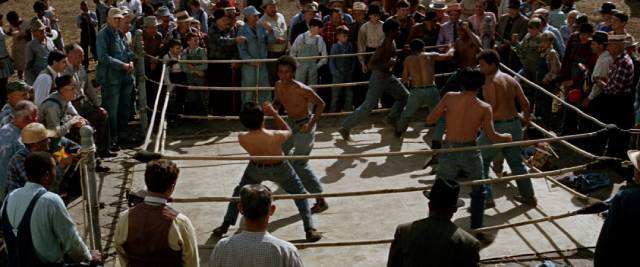
There are subtle differences between Parks’ depiction of race in American society and the mainstream movies which had preceded his. Classical Hollywood tended to accept and reinforce prejudice, caricaturing Black characters with broad stereotypes; with the seismic shifts of the Civil Rights movement in the ’50s and ’60s, this began to change, but was still seen from a white point of view, with movies like Stanley Kramer’s The Defiant Ones (1958) and Guess Who’s Coming to Dinner (1967), Ralph Nelson’s Lilies of the Field (1963) and James Clavell’s To Sir, With Love (1967) seemingly designed to reassure white audiences that despite increasing pressure for racial equality, those audiences had no cause to fear the demands being made. Parks’ movie was concerned with seeing the world from a Black point of view, not with offering an idealized, non-threatening figure like those portrayed by Sidney Poitier.
The approach taken in The Learning Tree seems to appropriate the familiar forms of traditional Hollywood storytelling, naturalizing Black experience through the use of a classical style used in many previous movies about boys coming of age in small towns. If the racial point of view was new, the style with its attention to period detail and nostalgic appeal was almost old-fashioned. A few years later, it would be emulated by Sounder (1972), a similar story which, directed by a white liberal (Martin Ritt), would be nominated for several Oscars – an honour not afforded Parks’ film.
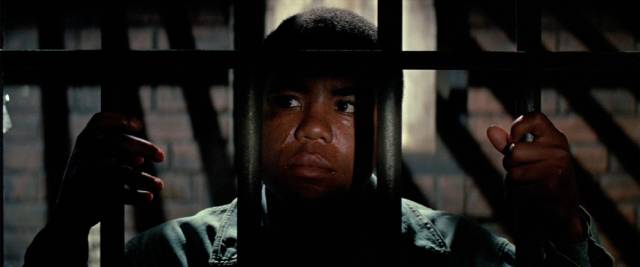
Having broken through the race barrier in Hollywood, Parks had paved the way for other Black filmmakers, though the process remained slow – the following year, Melvin Van Peebles, who had had to go to France to start his own feature-making career, was able to make The Watermelon Man (1970) at Columbia, though that unsatisfactory experience led to the following year’s angry explosion of Sweet Sweetback’s Baadasssss Song (1971), which turned out to be far more influential than The Learning Tree. Parks himself managed to tap into that anger while remaining, unlike Van Peebles, within the system, making Shaft for MGM; together with Sweetback, that movie launched the blaxploitation genre which quickly abandoned the subtle treatment of racial issues which was at the heart of Parks’ first feature.
*

The Disk
Criterion’s Blu-ray has been mastered from a 2K scan of a 35mm interpositive and it looks gorgeous, with lush colours and a film-like texture. The mono soundtrack is clear, with some depth and nuance.
The Supplements
A number of new and archival extras emphasize the film’s historical significance as well as its personal importance to Parks as a creative artist. A brief featurette from 1968 (7:19) focuses on the fact that this was the first studio film with a Black director, while a longer piece (27:15) also shot during production takes a more personal viewpoint as Parks’ son, Gordon Parks Jr, himself a photographer, observes the shoot and offers his own reactions to the work his father was engaged in.
Two new pieces produced by Criterion examine Parks and his work from a modern perspective. Curator Rhea L. Combs and filmmakers Ina Diane Archer, Ernest R. Dickerson and Nelson George discuss the impact of the film on them and other Black filmmakers (29:20), while artist Hank Willis Thomas and art historian Deborah Willis discuss with film scholar Michael B. Gillespie Parks’ work as a photographer and its importance to his filmmaking (17:58).
In addition, two documentaries from 1968 are included: Diary of a Harlem Family (20:17) was written and narrated by Parks, while he directed The World of Piri Thomas (59:30). Both are stark depictions of impoverished lives in Harlem, fraught with domestic violence, crime and despair, mitigated to some degree by a human capacity to endure. They are introduced by Rhea L. Combs and Nelson George (8:35).
There’s a trailer (4:01) and a booklet which, oddly, doesn’t include any critical writing about the film, but reprints a 1963 piece by Parks from Life which juxtaposes excerpts from the novel with photographs which prefigure the imagery of the film, plus a section from one of his memoirs dealing with the making of the film.
Comments